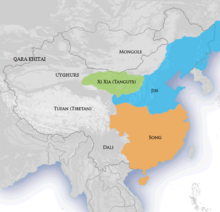Jin Dynasty (1125-1234)
The Jin Dynasty ( Chinese 金朝 , Pinyin Jīn Cháo ) of the 12th and 13th centuries was a Tungus dynasty in northeast China that founded its own state in 1125 on the ruins of the Liao Empire of the Kitan . The Jin rulers belonged to the Jurchen people , some of whom later became Manchu ancestors . The Manchu referred to their founding of the dynasty in the early 17th century as the Later Jin Dynasty .
history
With the help of mercenaries from the Mongolian steppe, the Jurchen ruled the majority of the Han Chinese in northern China. The Jin Empire then had a total of 53 million inhabitants, including 6 million Jurchen, making it the most populous state on earth. At the beginning of 1126, the Jurchen surrounded Kaifeng , the capital of the Song Dynasty , whose emperor Huizong was captured after the city fell in January 1127.
The capital of the Jin Empire was initially Huei-ing ( Huining , 1125-1153) near Harbin in Manchuria, now Acheng . The Sinization of the Jurchen nobility accelerated when the despotic Emperor Tikunai ( Wanyan Liang) moved the capital to Beijing in 1153 and finally even briefly to Kaifeng. But Tikunai failed in his attack on Song China in 1161 on the Yangtze and was killed by his soldiers.
Under his successor Wulu, the capital was temporarily moved back to Manchuria. This was in connection with measures taken by traditional circles against Sinization. In 1173 the Jurchen were forbidden to use Chinese names. At the same time, the Jurchen language was made mandatory for official exams.
From 1153 to 1214 Zhōngdū ( 中 都 - "middle capital") was again the capital, today's Beijing. In 1194, the Yellow River shifted its course, causing several floods. Despite this catastrophe, the aforementioned pressure on the government and a new war against the Song 1208, the Jurchen rule was outwardly stable on the eve of the Mongol attack . Only inwardly did one see the unreliability of the army, a quarter of which consisted of mercenaries from the steppe.
The Jin occasionally undertook punitive expeditions to Mongolia , and from 1192 onwards they also reinforced the Great Wall . But the establishment of the Mongol Empire in 1206 was a serious challenge for them. After the conquest of Beijing by the Mongol Khan Genghis , Kaifeng became the last capital in 1214-1234. The empire of the Jin dynasty fell in 1234 with the conquest of Kaifeng and Luoyang by Ögedei Khan .
Jin Dynasty Emperor (1125-1234)
| Temple name | Posthumous title | Birth Name | Reign | Government currencies |
|---|---|---|---|---|
| Taizu 太祖 | Wanyan Aguda ( 完顏 阿骨打 , Wányán Āgǔdǎ ) | 1115-1123 |
Shōuguó收 國 1115–1116 Tiānfǔ天 輔 1117–1123 |
|
| Taizong 太宗 | Wanyan Wuqimai ( 完顏 吳 乞 買 , Wányán Wúqǐmǎi ) or Wanyan Sheng ( 完顏 晟 , Wányán Shèng ) |
1123-1134 | Tiānhuì天 會 1123–1134 | |
| Xizong 熙宗 | Wanyan Hela ( 完顏 合 剌 , Wányán Hélá ) or Wanyan Dan ( 完顏 亶 , Wányán Dǎn ) |
1135-1149 |
Tiānhuì天 會 1135–1138 Tiānjuàn天眷 1138–1141 Huángtǒng皇 統 1141–1149 |
|
| - | Hailing Wang ( 海陵 王 , Hǎilíng Wáng ) | Wanyan Liang ( 完顏亮 , Wányán Liàng ) | 1149-1161 |
Tiāndé天 德 1149–1153 Zhènyuán貞元 1153–1156 Zhènglóng正隆 1156–1161 |
| Shizong 世宗 | Wanyan Yong ( 完顏 雍 , Wányán Yōng ) | 1161-1189 | Dàdìng大定 1161–1189 | |
| Zhangzong 章 宗 | Wanyan Jing ( 完顏 璟 , Wányán Jǐng ) | 1190-1208 |
Míngchāng明昌 1190–1196 Chéng'ān承 安 1196–1200 Tàihé泰和 1200–1208 |
|
| - | Weishao Wang ( 衛 紹 王 , Wèishào Wáng ) or Weiwang ( 衛 王 , Wèiwáng ) |
Wanyan Yongji ( 完顏 永濟 , Wányán Yǒngjì ) | 1209-1213 |
Dà'ān大安 1209–1212 Chóngqìng崇慶 1212–1213 Zhìníng至 寧 1213 |
| Xuanzong 宣宗 | Wanyan Xun ( 完顏 珣 , Wányán Xún ) | 1213-1223 |
Zhēnyòu貞 祐 1213–1217 Xīngdìng興 定 1217–1222 Yuánguāng元 光 1222–1223 |
|
| Aizong 哀 宗 | Wanyan Shouxu ( 完 顏守緒 , Wányán Shǒuxù ) | 1224-1234 |
Zhèngdà 正大 1224–1232 Kāixīng開 興 1232 Tiānxīng天 興 1232–1234 |
|
| - | Modes 末帝 | Wanyan Chenglin ( 完 顏承麟 , Wányán Chénglín ) | 1234 | - |
literature


- Frederick W. Mote: Imperial China. 900-1800. Harvard University Press, Cambridge MA et al. 1999, ISBN 0-674-44515-5 .
- Jing-shen Tao: The Jurchen in Twelfth-Century China. A Study of Sinicization (= Publications on Asia of the Institute for Comparative and Foreign Area Studies. 29). University of Washington Press, Seattle WA u. a. 1976, ISBN 0-295-95514-7 ( Publications on Asia of the Institute for Comparative and Foreign Area Studies , 29).
Web links
- Jin-Song relations (English)
Individual evidence
- ^ Dieter Kuhn : The Age of Confucian Rule. The Song Transformation of China. Belknap Press of Harvard University Press, Cambridge MA et al. 2009, ISBN 978-0-674-03146-3 , pp. 67-70; Frederick W. Mote: Imperial China. 900-1800. 1999, p. 290 f.
- ↑ Lt. Xiàndài Hànyǔ cídiǎn现代 汉语 词典 (Beijing, Shāngwù yìnshūguǎn 商务印书馆 1996), ISBN 7-100-01777-7 , p. 1705, the character 晟 is not pronounced chéng , but shèng .


